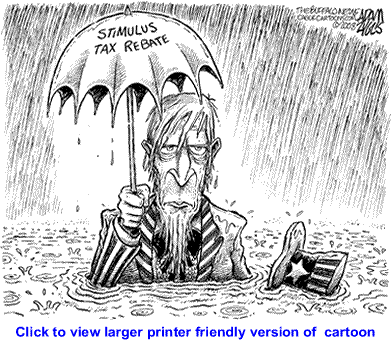

| Visitors Now: | |
| Total Visits: | |
| Total Stories: |

| Story Views | |
| Now: | |
| Last Hour: | |
| Last 24 Hours: | |
| Total: | |
How Quantitative Easing is Destroying the U.S. Economy
By James West
MidasLetter.com
Tuesday, October 23, 2012
 While we have seen that capital fabrication and insertion into the banking system (better known as Quantitative Easing) can have a substantial impact on corporate earnings and commodity prices, we have also now recognized that such effects are short-lived, as market participants quickly learn to buy in front of such tactics, and sell into them once deployed. We are also now witnessing that open-ended incremental capital fabrication and insertion into the banking system is unable to replicate the results of previous quantitative easing events, for the simple reason that they are not sufficient in scale or scope to alter investor sentiment in the face of real economic contraction.
While we have seen that capital fabrication and insertion into the banking system (better known as Quantitative Easing) can have a substantial impact on corporate earnings and commodity prices, we have also now recognized that such effects are short-lived, as market participants quickly learn to buy in front of such tactics, and sell into them once deployed. We are also now witnessing that open-ended incremental capital fabrication and insertion into the banking system is unable to replicate the results of previous quantitative easing events, for the simple reason that they are not sufficient in scale or scope to alter investor sentiment in the face of real economic contraction.
I’ve said it before and I’m evidently going to be repeating myself, but the illusion of “recovery” that the political class desperately clings to and that is dutifully parroted by the financial media, is nothing more than the effect of massive financial fabrication and insertion into the banking system piling up as earnings and higher commodity prices. This is the very real reason why employment continues to weaken, despite what the selectively rigged reports of the Department of Labor Statistics purports to tell us.
But there is a new effect emerging from this environment of cost-free capital, and it is best exemplified in the phenomenon referred to as “dividend recapitalization”.
In this latest scheme foisted on the general population by unscrupulous bankers (like Mitt Romney – Bain Capital is at the forefront of dividend recaps, as they’re called), companies with strong balance sheets and earnings are encumbered with debt by their controlling private equity owners, and the debt is paid out as dividends to the private equity shareholders.
The sole reason that this is possible is that the cost of debt for prime bank customers is next to nothing, and so loading them up with debt is the technique favored by private equity to squeeze extra earnings from their investments.
Unfortunately, the result is a much higher bankruptcy rate among corporations owned by private equity groups who subject them to such dividend recaps. In fact, the rate of bankruptcy is roughly double. (Thirteen percent as opposed to 6 percent for non-encumbered businesses.)
“Debt issued to fund private-equity dividends has topped $54 billion this year, after a flurry of deals earlier this month, according to Standard & Poor’s Capital IQ LCD data service. That is already higher than the record $40.5 billion reached in all of 2010, when credit markets reopened after the crisis.
Also some of these deals involve a risky type of debt known as “payment in kind toggle”—or PIK-toggle—bonds that give companies the choice to defer interest payments to investors. Instead, they could opt to add more debt to the balance sheet. The default rate for companies that sold PIK-toggle bonds was 13% from 2006 to 2010, twice the default rate for comparably rated companies that didn’t use the bonds, according to a study by Moody’s Investors Service.”
So when companies owned by private equity groups load up their portfolio companies with debt, and squeeze every last nickel out of them, they have the habit of driving formerly viable businesses into bankruptcy. And when they go bankrupt, they put the entire payroll out onto the street.
The rate at which these junk financings are happening is on the rise, implying that the destruction of the baseline U.S. economy is escalating.
According to Ben Feder, special counsel at Kelly Drye;
“Even as the financial crisis of 2008-09 began to ebb, the so-called “wall of debt” loomed large. Hundreds of billions of dollars of leveraged and high yield debt issued during the irrational exuberance era was coming due by 2014, threatening to drive up default rates and posing an ongoing threat to the health of the international financial markets.
Those fears seem very distant today. First, the “wall” got pushed back, as lenders and debt investors engaged in an ongoing game of what came to be colloquially referred to as “amend, extend and pretend”, renegotiating maturity dates in an effort to delay the day of reckoning. Now, thanks in no small part to central bankers’ determination to keep interest rates as low as possible, a white-hot high yield debt market has broken the wall into pieces, with parts of it not to be reassembled for decades. High yield (aka “junk”) debt issuances have returned to levels not seen since 2007, and are allowing leveraged companies to refinance pending obligations with maturities in some instances of as long as 30 years.”
The takeaway here is that if you reduce the cost of money to nothing and then create exponentially greater amounts of it, it becomes a catalyst for its own destruction. Think of a ship taking on water. Then imagine a torrential downpour in stormy seas. That’s the United States economy.
**********************************************************************************
Midas Letter is the Journal of Investment Strategy of the Midas Letter Opportunity Fund, a Luxembourg-based Special Investment Fund that specializes in Canadian-listed emerging companies in the resource sector with a focus on precious metals explorers and miners. James West is the Portfolio and Investment Advisor to the fund.
Every month, James West’s MidasLetter Premium Edition deconstructs the economic and political events of the past and upcoming week, and identifies risks and opportunities to investors seeking to profit while the majority of investors are losing money.
With a track record extending back 10 years in precious metals-related assets, Midas Letter provides actionable, accurate, and un-biased information every week that saves subscribers losses from exposure to mis-identified trends, and directs them to high performance investments.
Subscribe now for $49 per month, or $499 for one year, at http://www.midasletter.com/subscribe.php. 30 day instant refund period from your first subscription day if not 100% satisfied.
**********************************************************************************
2012-10-24 04:13:21
Source: http://www.midasletter.com/index.php/how-quantitative-easing-is-destroying-the-u-s-economy/
Source:


